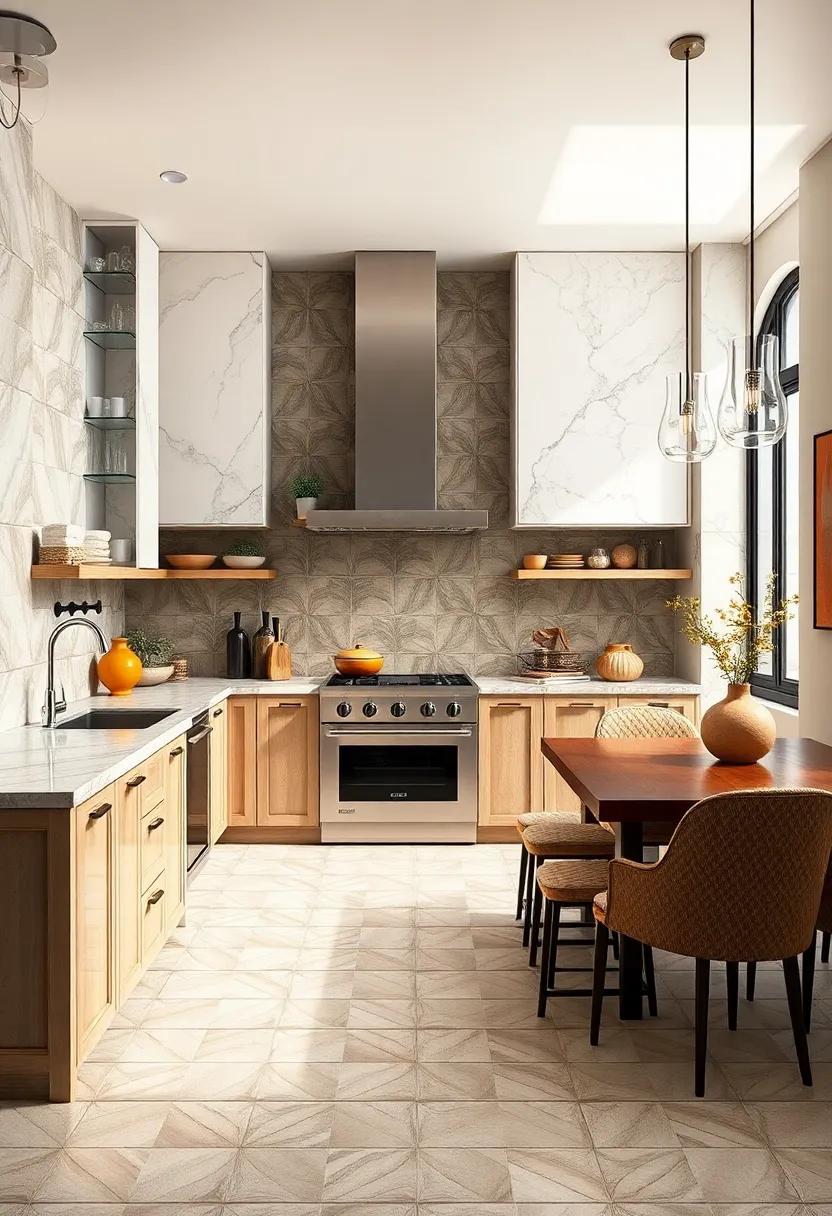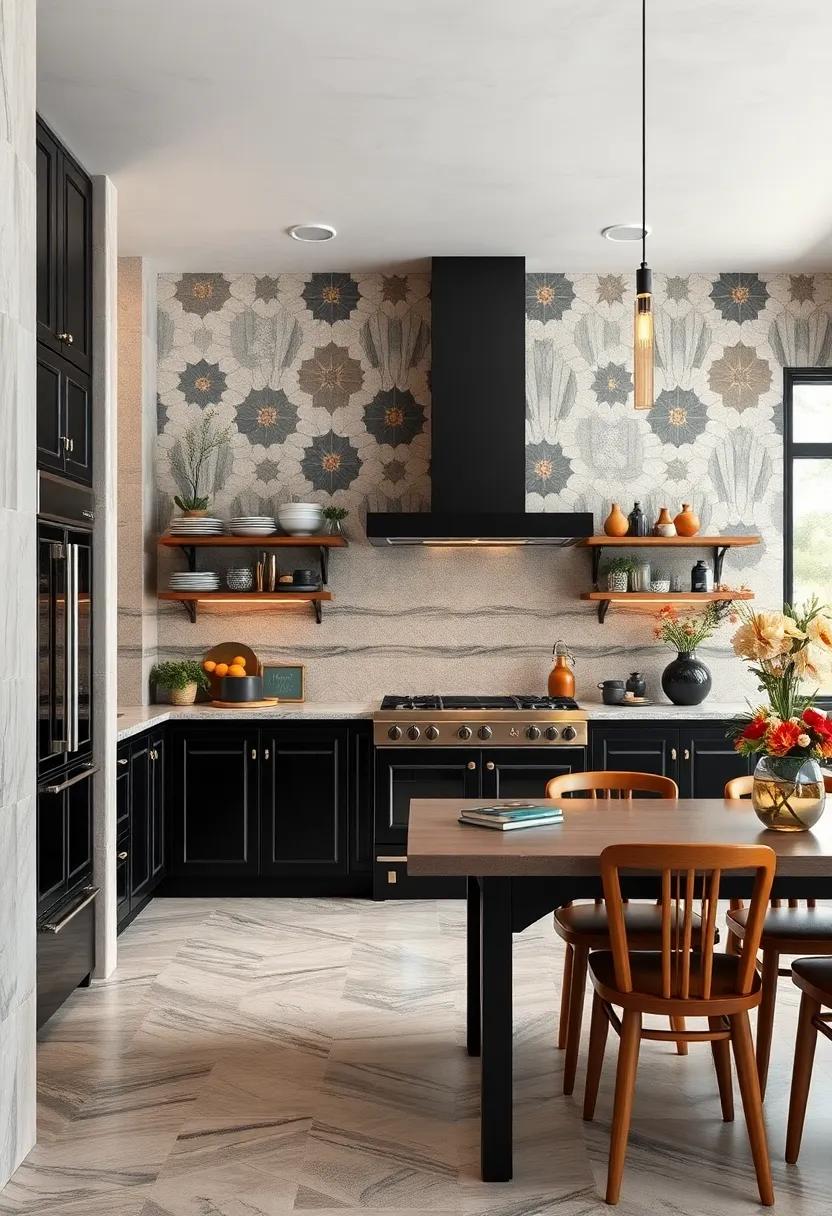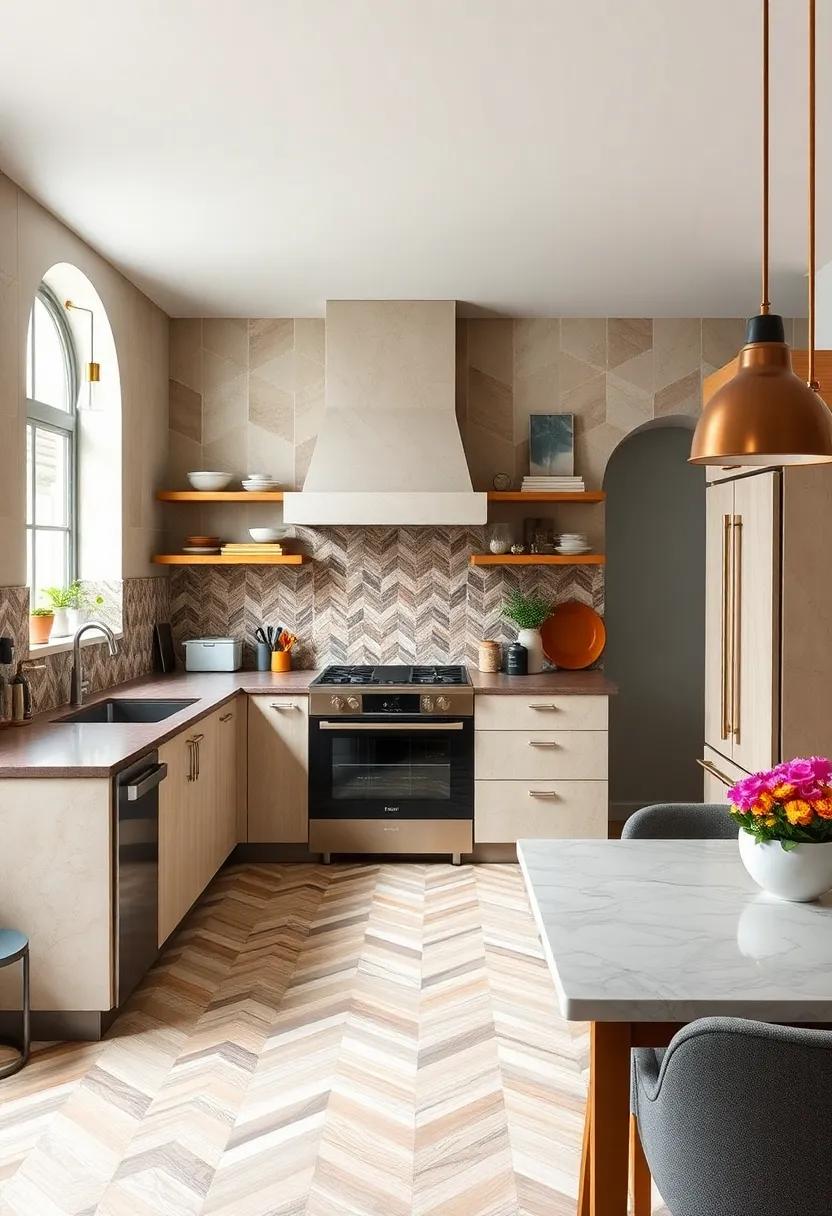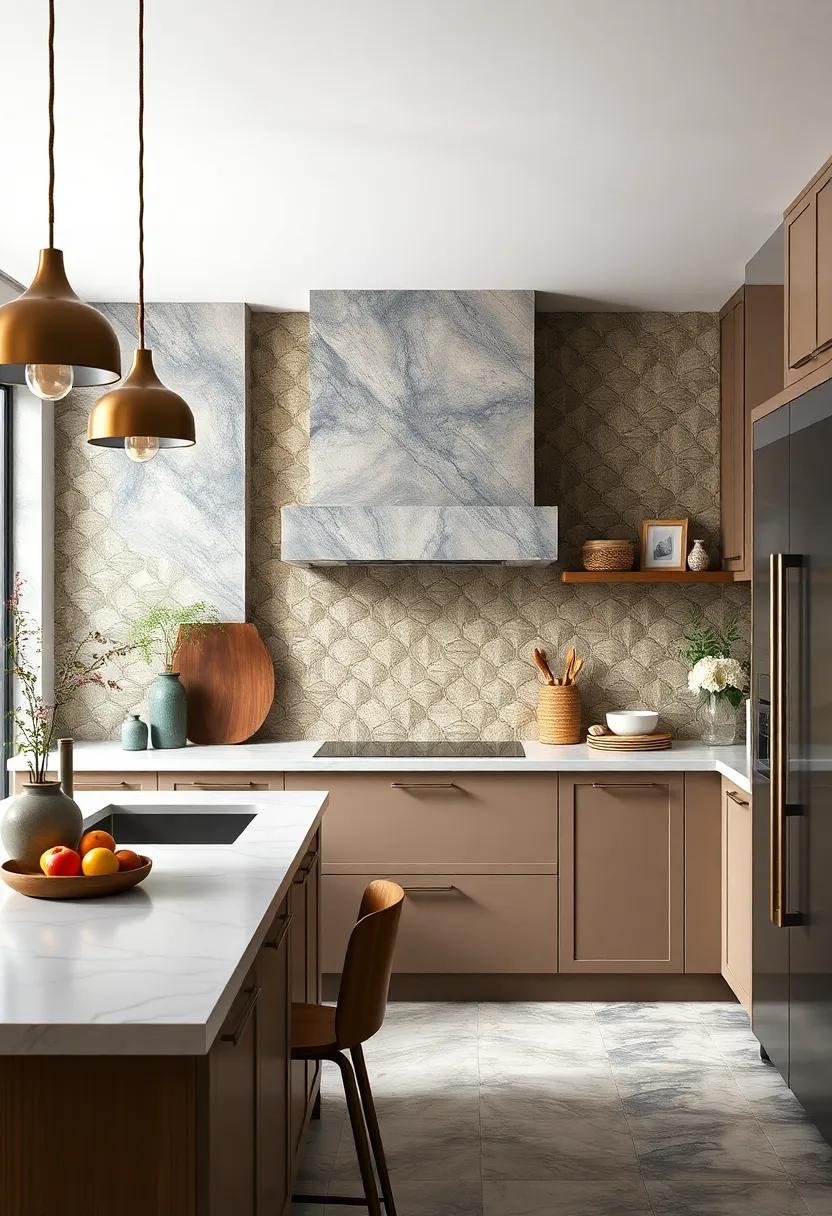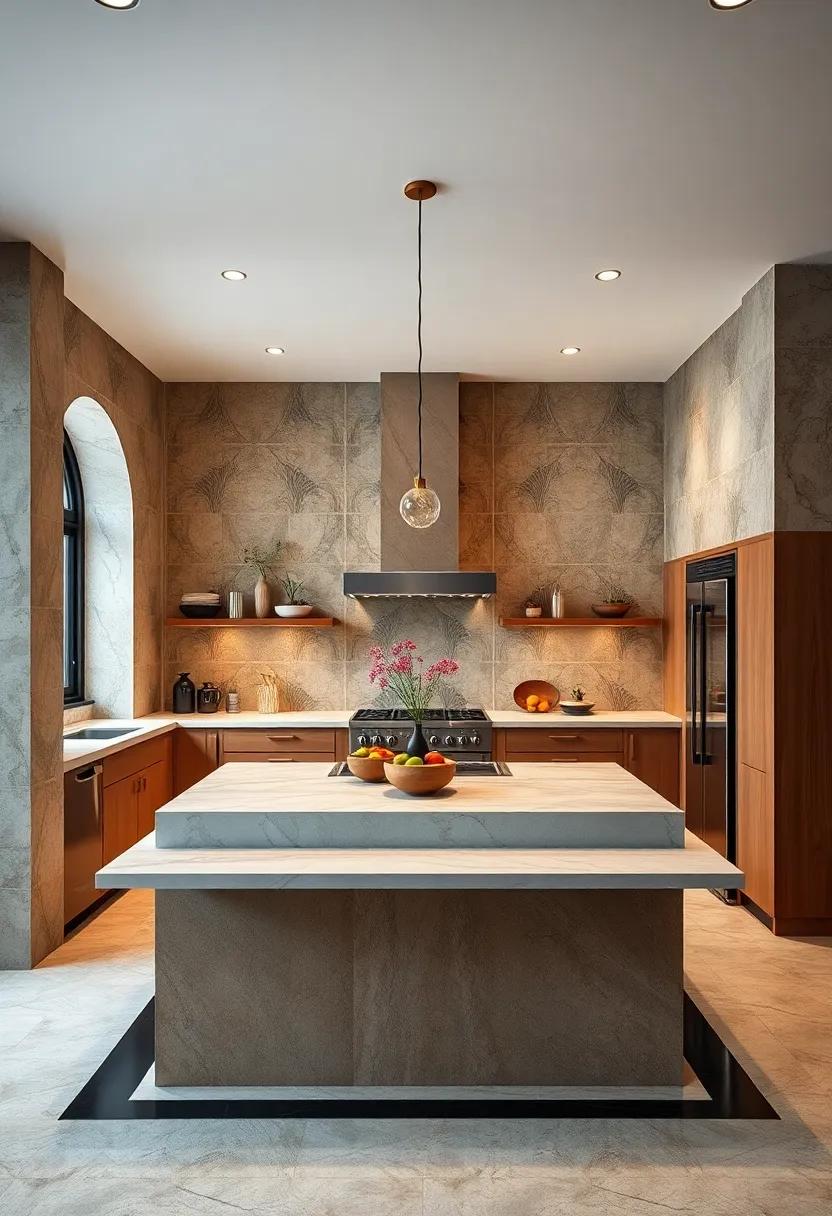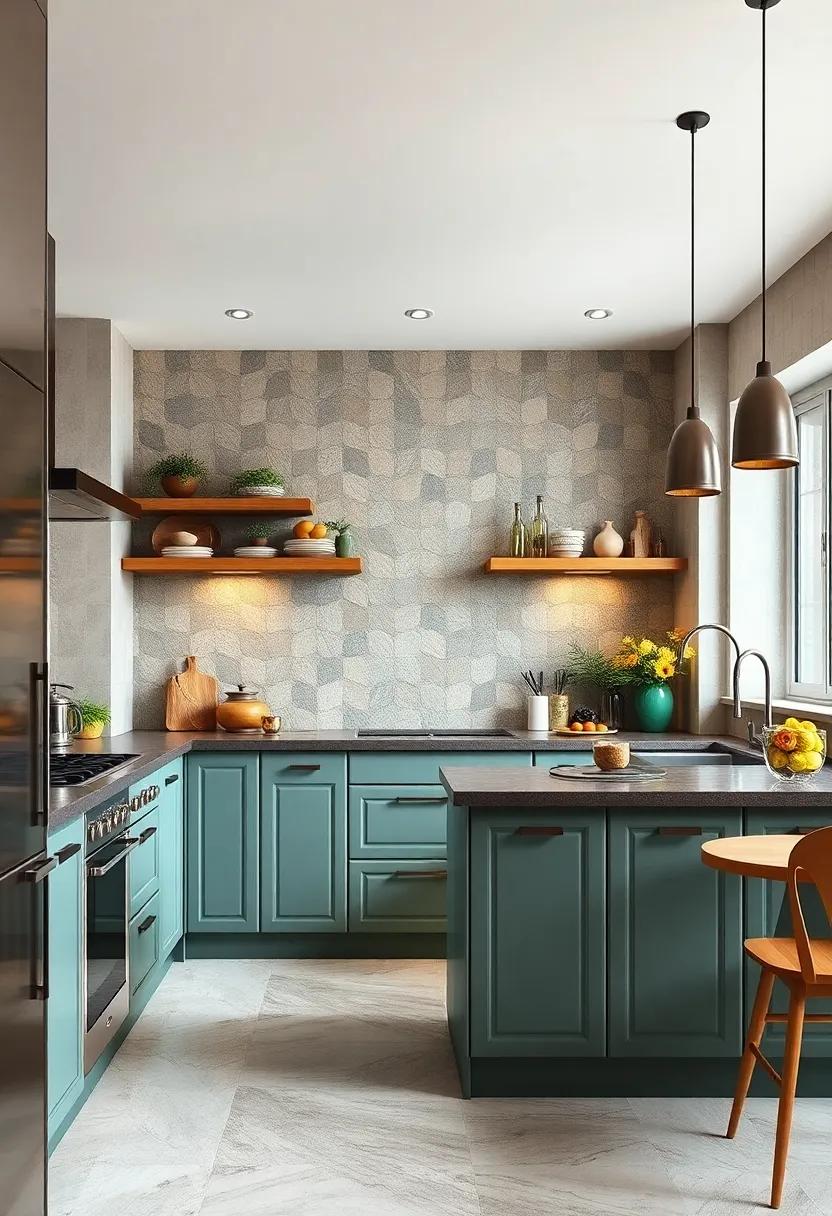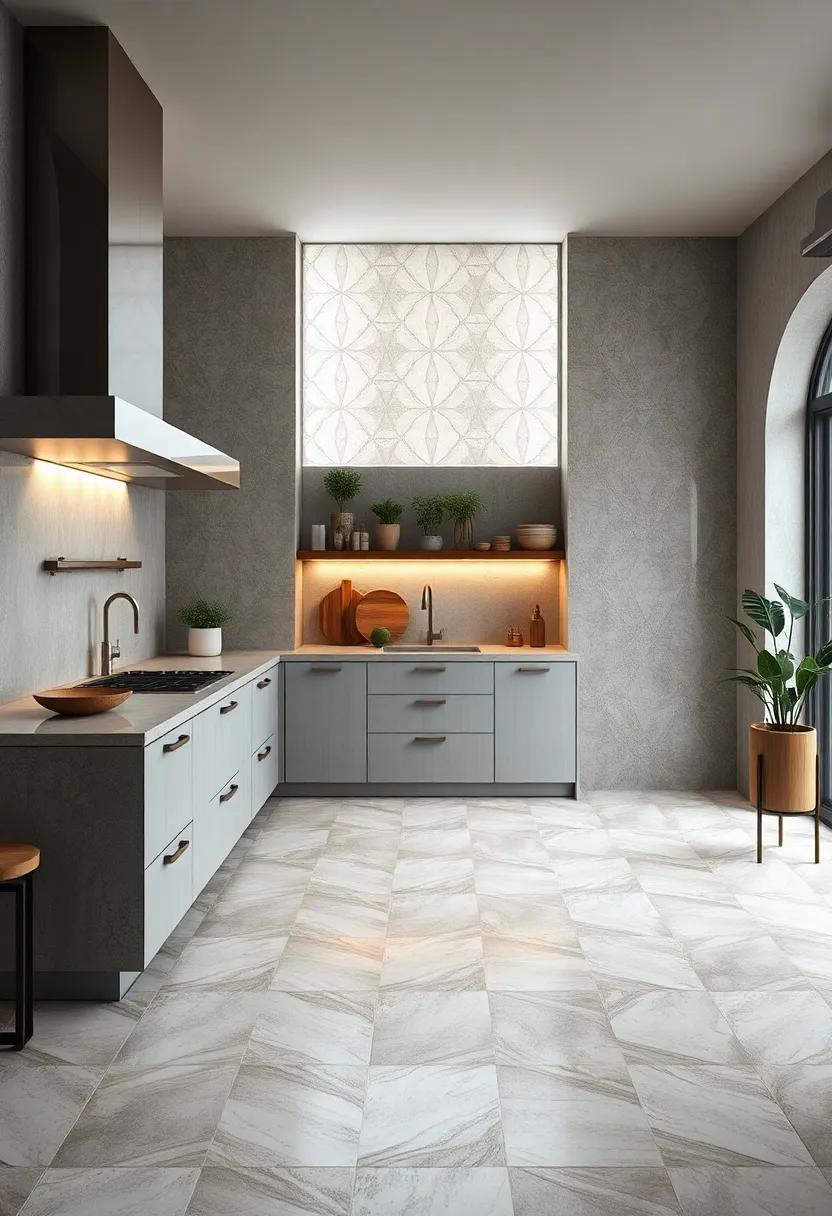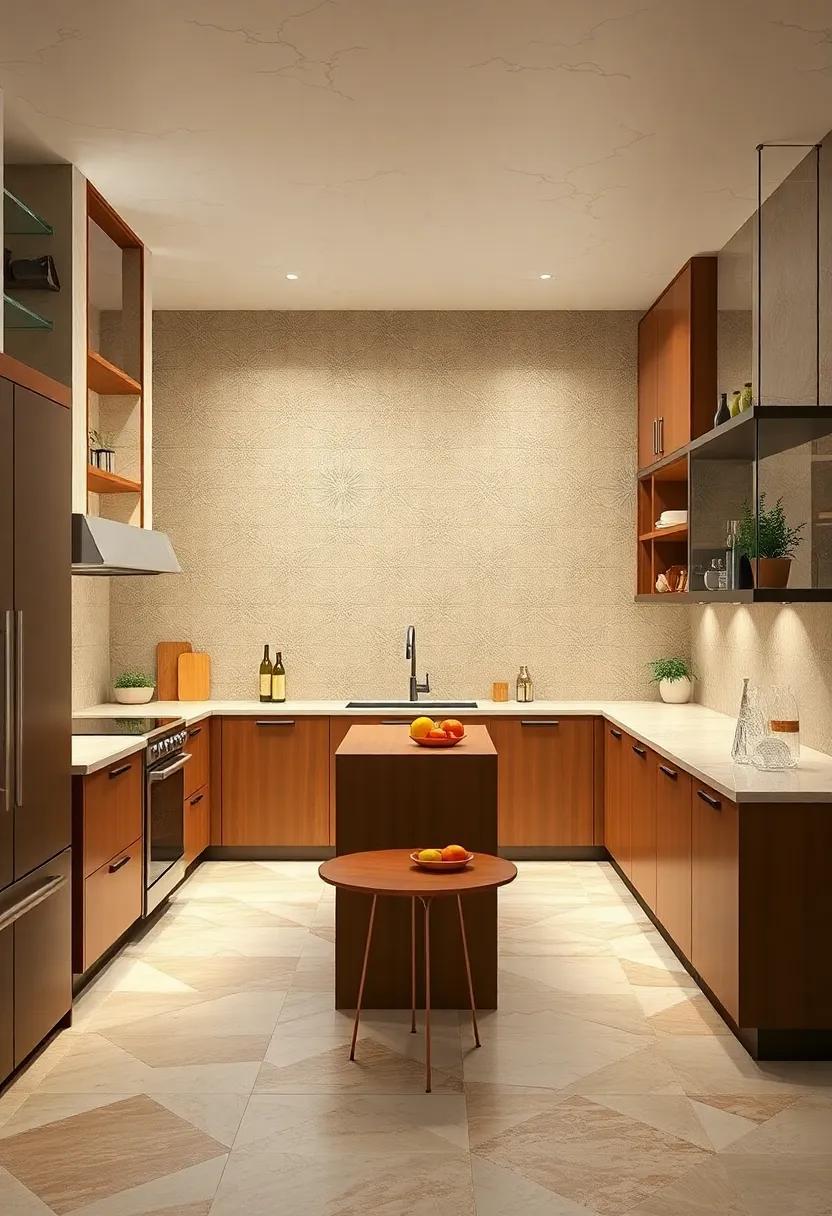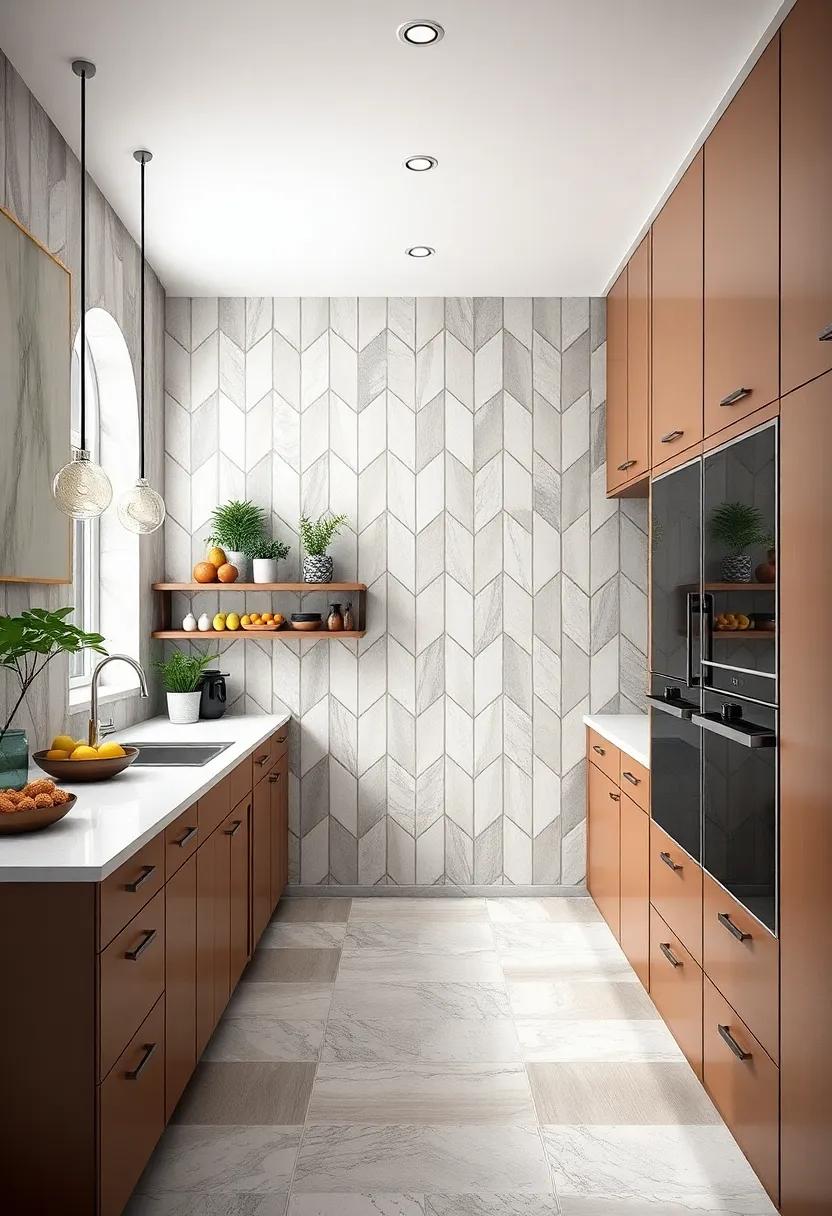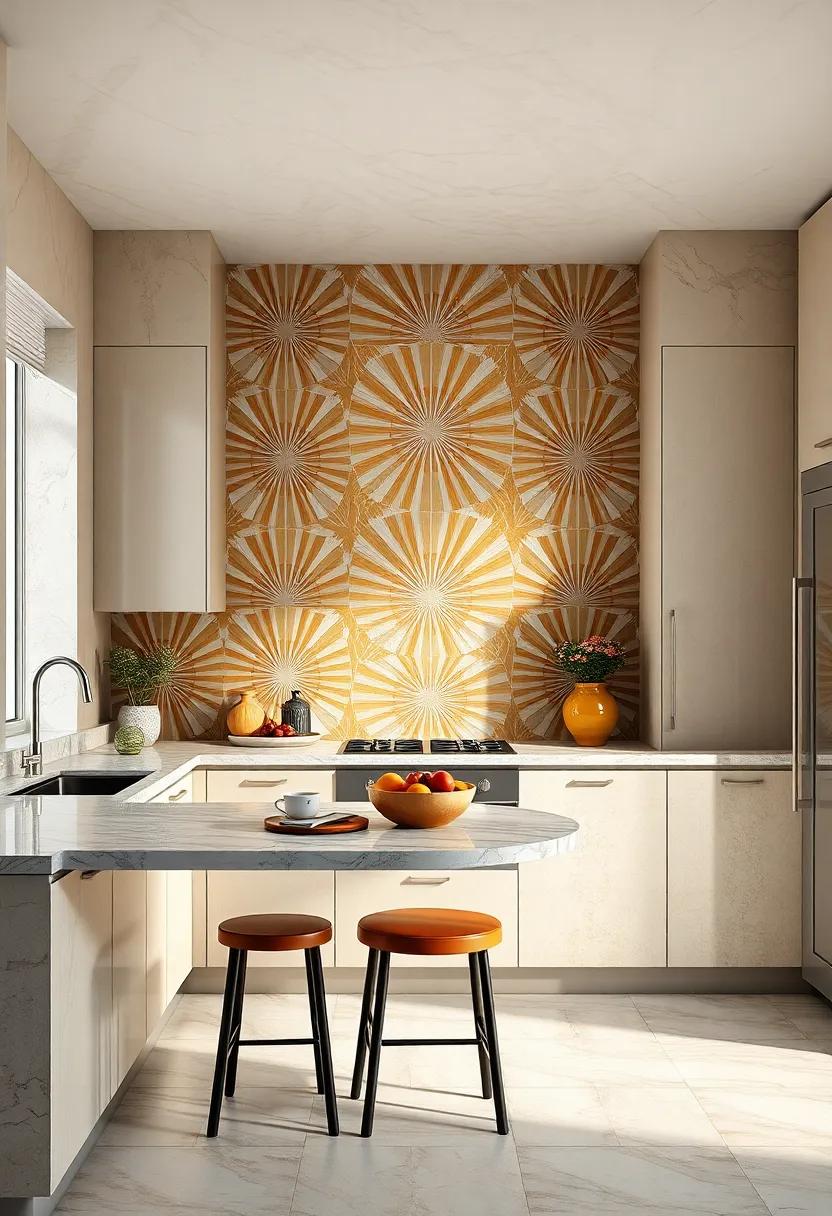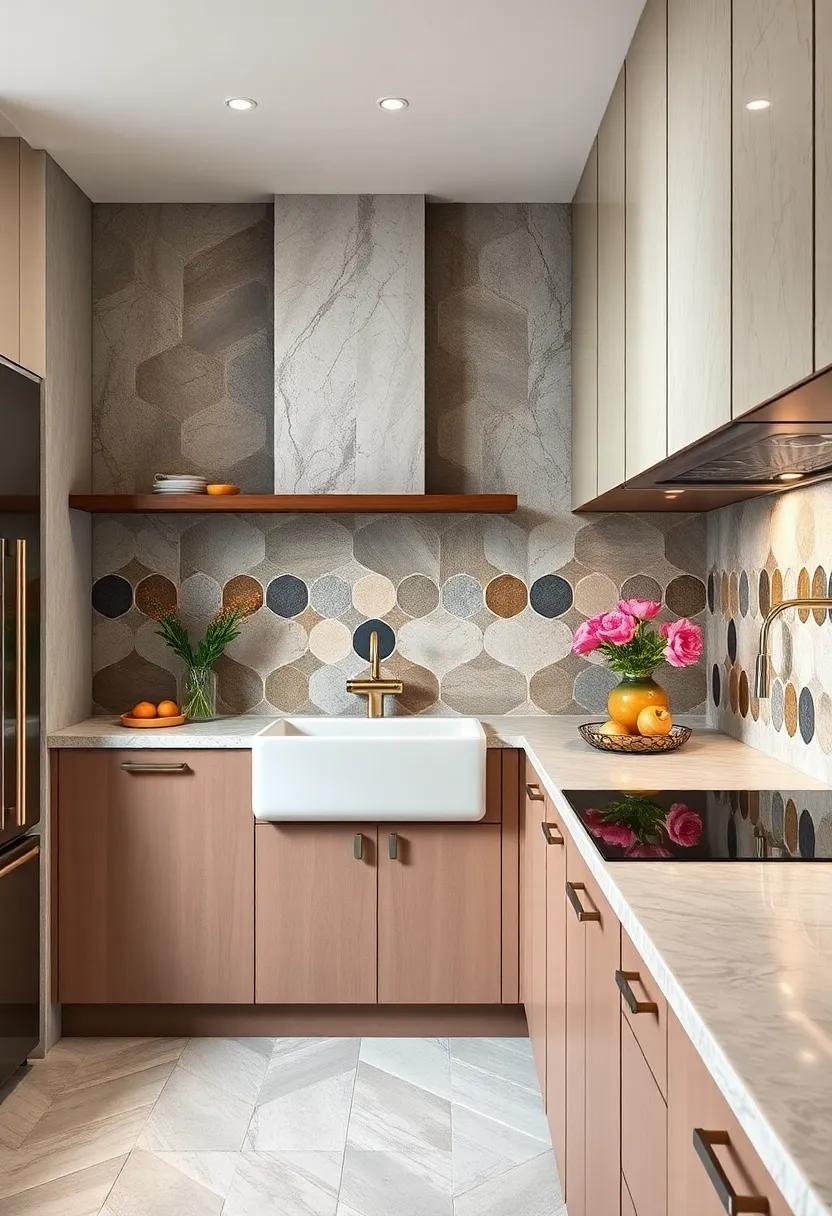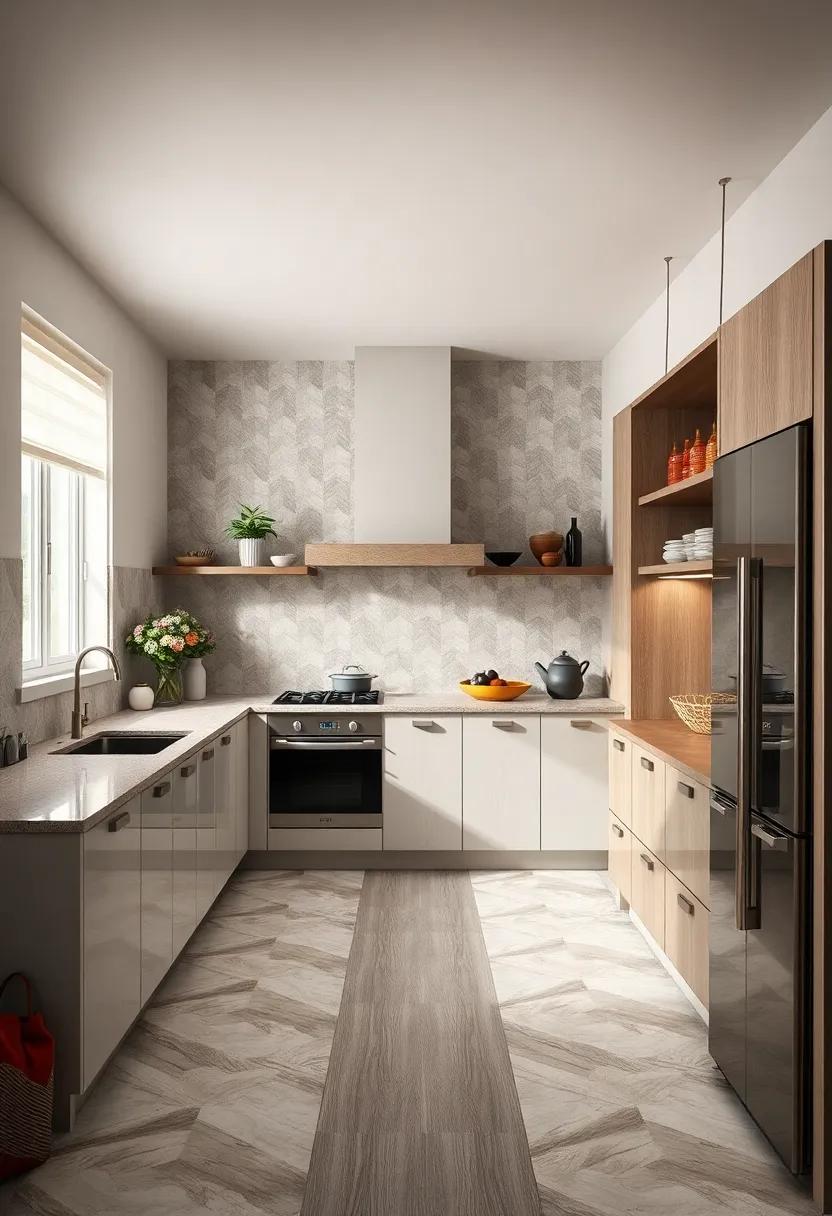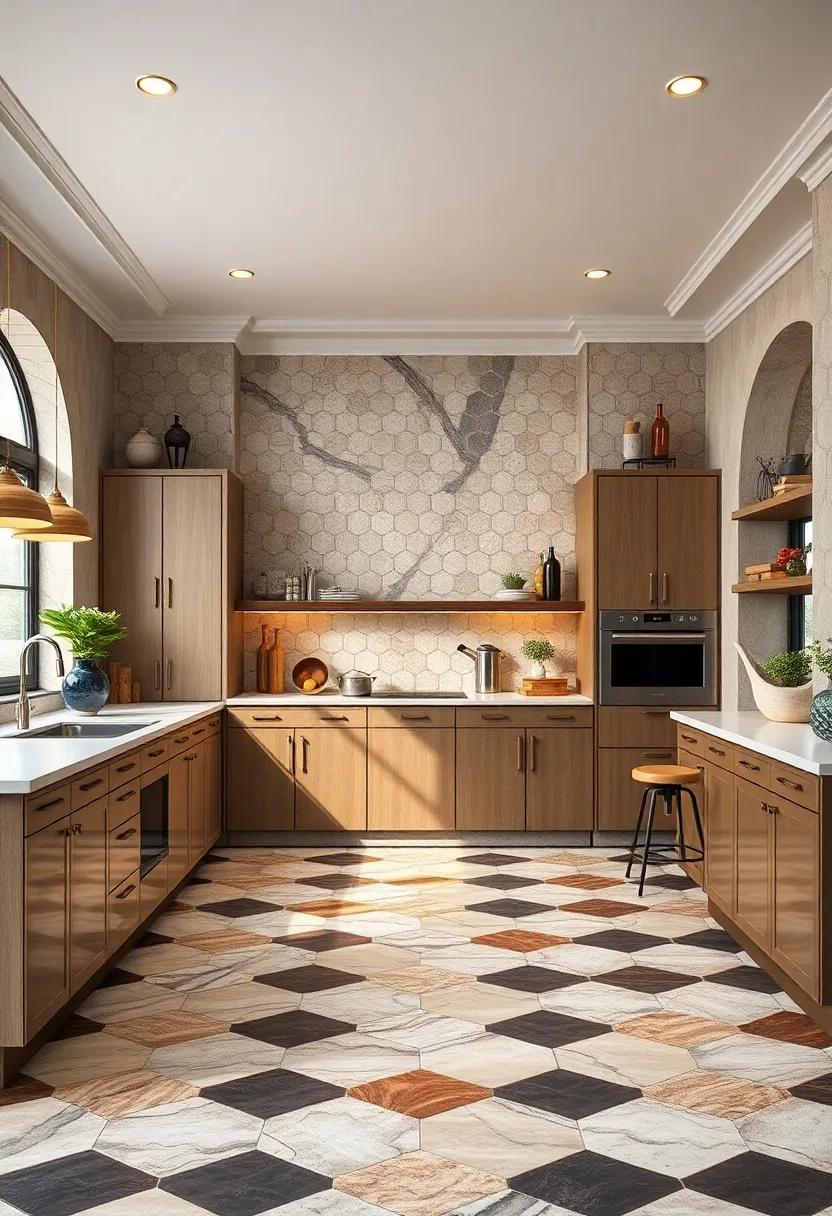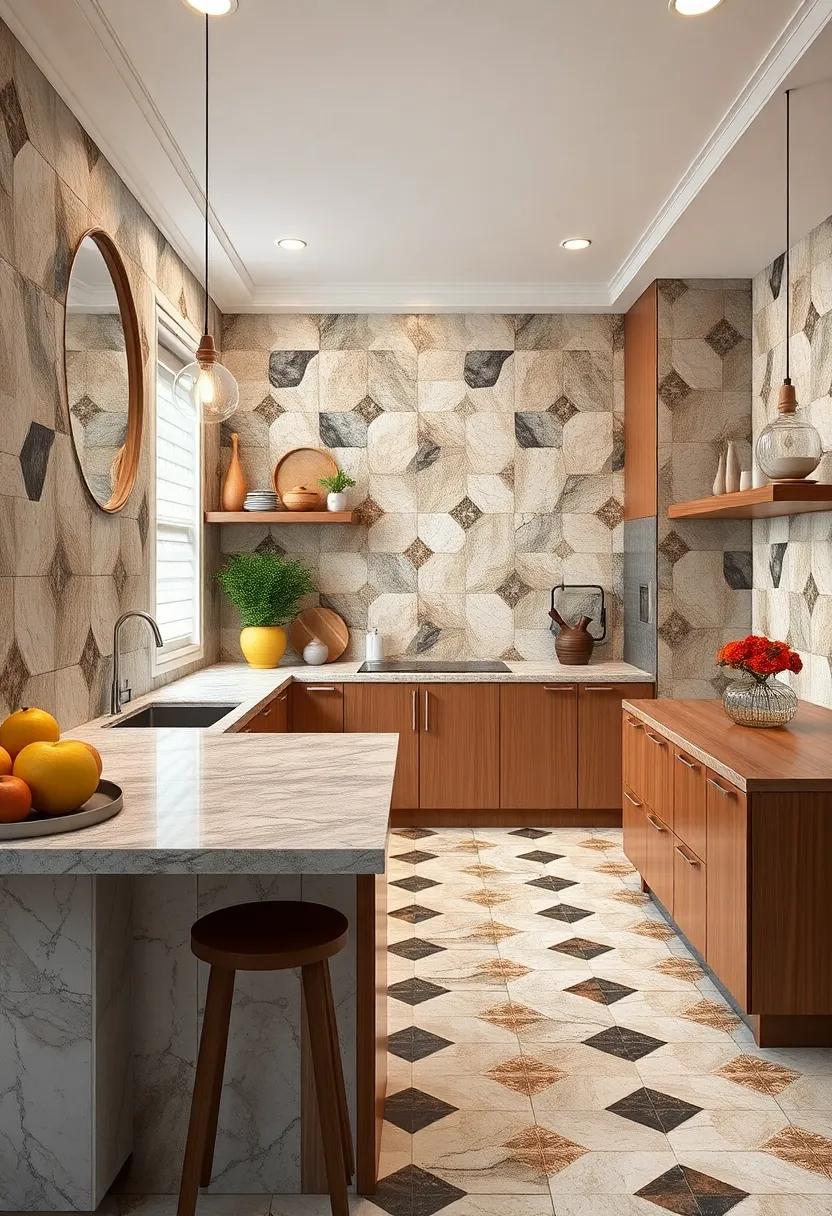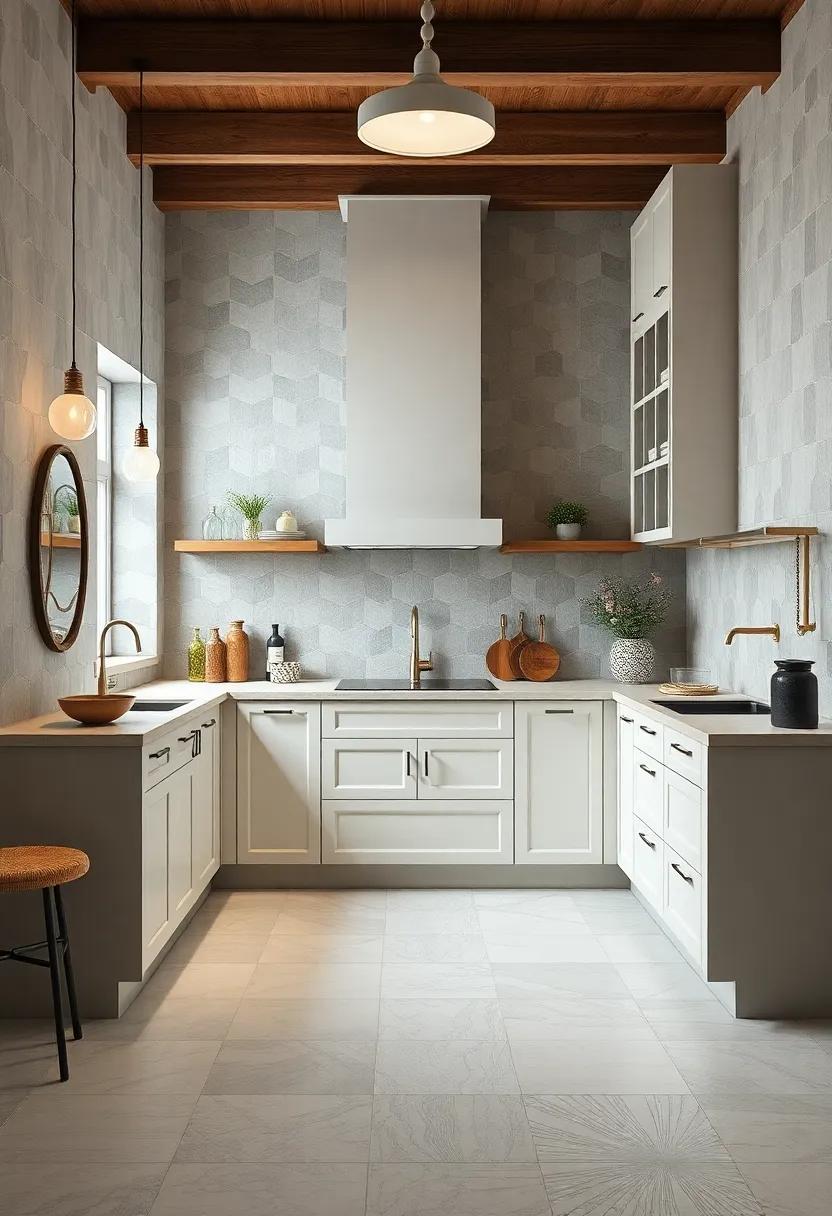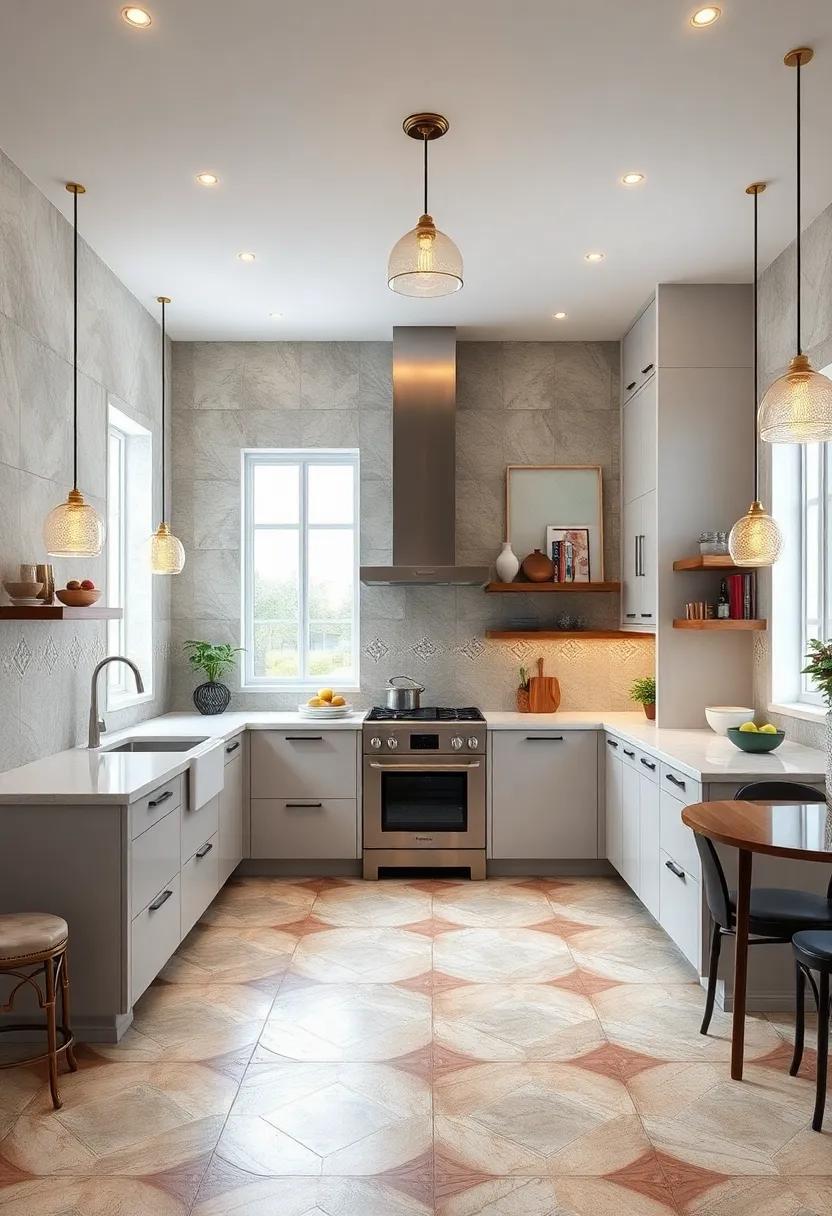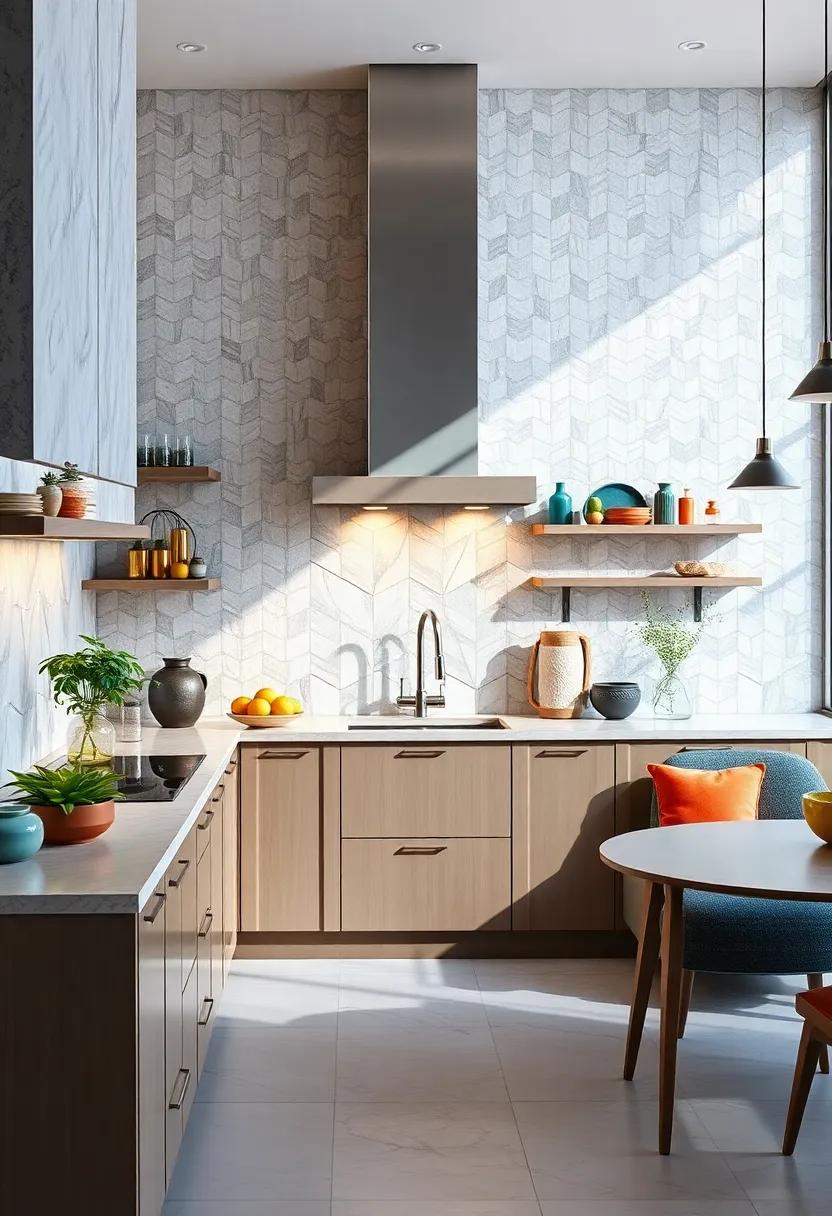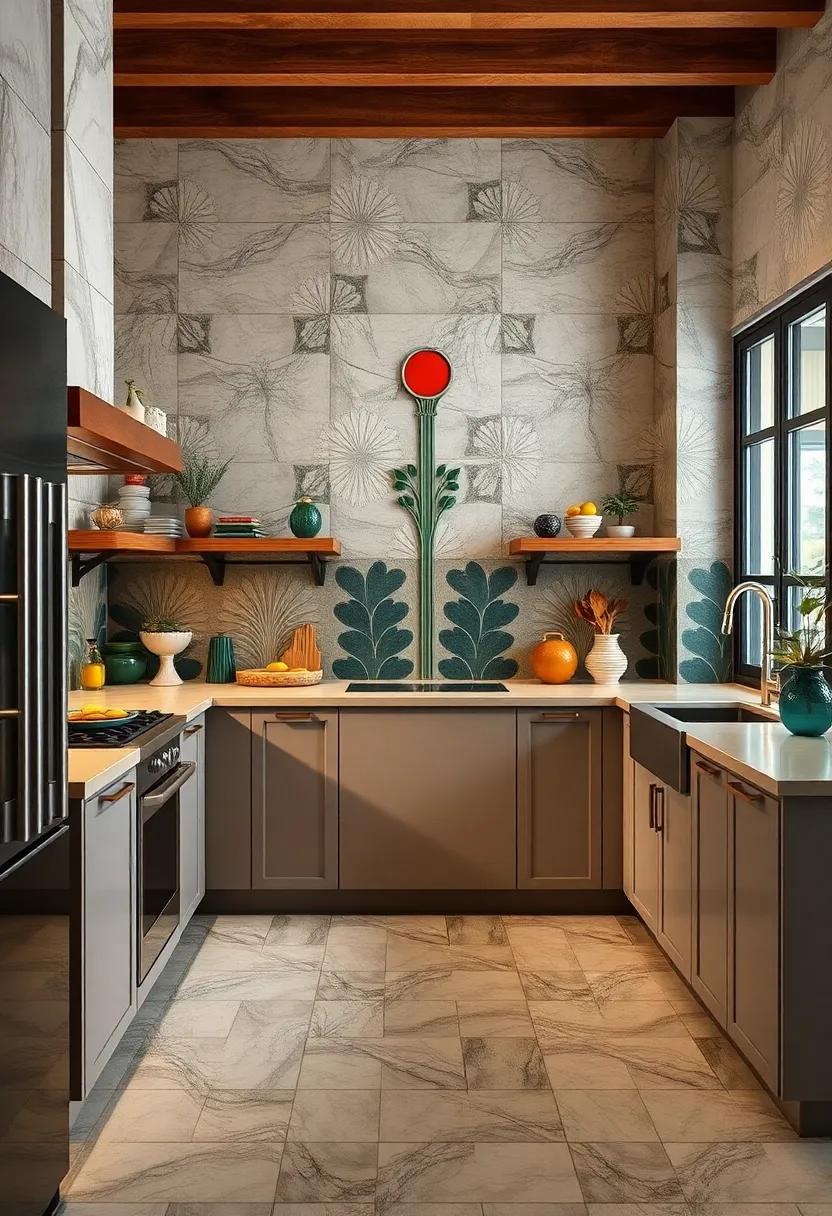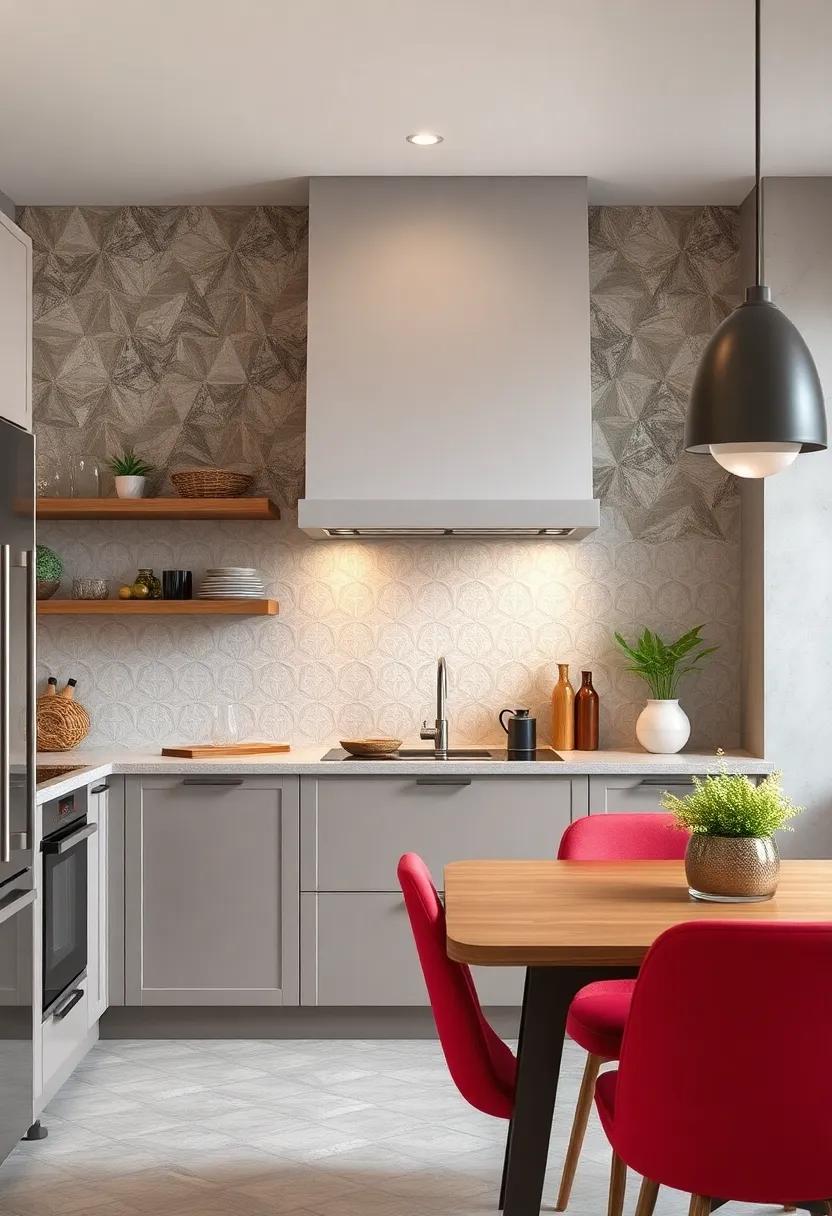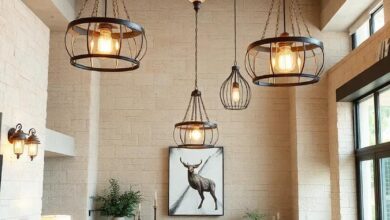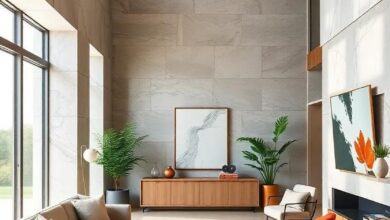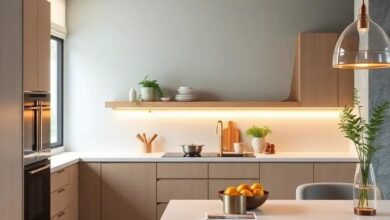Timeless Elegance: Art Deco Kitchens Featuring Bold Geometric Tiles
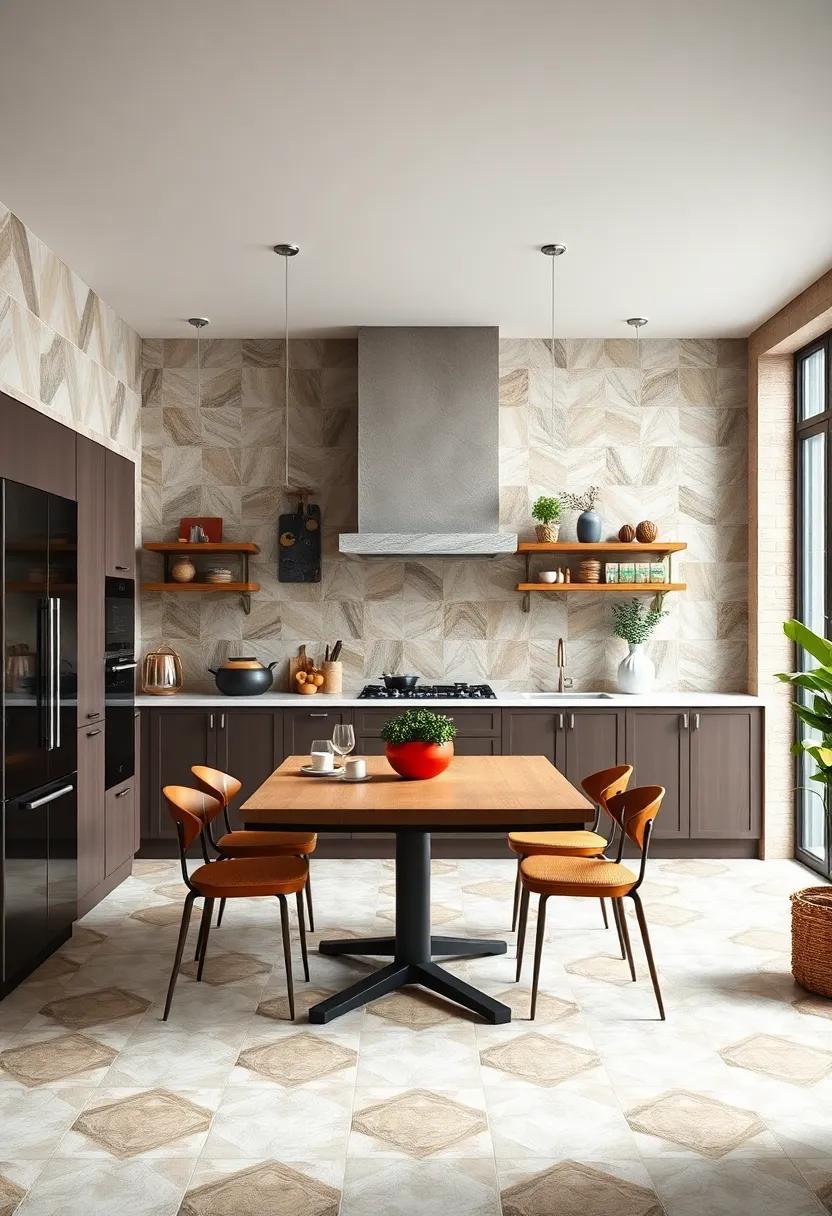
Step into a world where form meets function in striking harmony-welcome to the realm of Art Deco kitchens. Defined by bold geometric patterns, gleaming surfaces, and a sense of refined luxury, these spaces transform everyday cooking areas into timeless works of art. At the heart of this design renaissance lies the daring use of geometric tiles, whose symmetrical lines and vivid contrasts evoke a spirit both vintage and vibrantly modern. In this article, we explore how Art Deco kitchens continue to inspire with their enduring elegance, proving that classic style can boldly fuel contemporary creativity.
Timeless Elegance Showcased Through Bold Geometric Tiles in Luxurious Art Deco Kitchen Designs
Incorporating bold geometric tiles into Art Deco kitchens creates a visually striking juxtaposition of opulence and structure. These tiles, often featuring intricate patterns such as chevrons, zigzags, and fan motifs, serve as a foundation that celebrates both form and function. The interplay between sharp lines and luxurious materials like polished brass, marble, and glass elevates the kitchen to a space that is not just utilitarian but also a refined statement of style. The use of daring contrasts in colors-black and white, deep emerald with gold accents, or rich navy paired with soft cream-brings depth and timeless charm to culinary spaces.
Designers often choose geometric tiles not only for their aesthetic appeal but for their versatility in defining different zones within a kitchen. From backsplashes to floor patterns and even countertop inlays, these tiles shape the experience of movement and light throughout the room. Key benefits include:
- Visual rhythm: Patterns naturally guide the eye and create dynamic visual flow.
- Durability: Porcelain and ceramic tiles withstand kitchen wear while maintaining elegance.
- Customizability: Tiles can be arranged in unique mosaics tailored to individual style preferences.
| Tile Pattern | Color Palette | Typical Application |
|---|---|---|
| Chevron | Black & White | Flooring |
| Fan Motif | Gold & Emerald | Backsplash |
| Zigzag | Deep Navy & Cream | Countertop Inlay |
Classic Black and Gold Color Schemes Enhancing the Drama of Art Deco Kitchen Spaces with Geometric Patterns
The pairing of black and gold in Art Deco kitchens creates a rich, dramatic backdrop that perfectly highlights the style’s signature geometric patterns. This bold color combination transforms even the simplest layouts into visually stunning statements. Sleek black cabinetry and countertops offer a sleek canvas, while gold accents-whether in hardware, fixtures, or tile detailing-introduce an air of luxury and warmth. When incorporated thoughtfully, these colors capitalize on Art Deco’s penchant for opulence without overwhelming the space, allowing each geometric motif to stand out vividly.
- Visual Contrast: The deep matte or glossy black surfaces create powerful contrasts with shimmering gold finishes, enhancing the perception of depth and texture.
- Pattern Focus: Using black and gold in alternating geometric tile shapes draws the eye along clean lines and bold angles, accentuating symmetry and rhythm.
- Timeless Appeal: This classic color duo complements the typical Art Deco materials such as mirrored glass, polished brass, and marble, ensuring the kitchen remains stylish for decades.
| Feature | Black | Gold |
|---|---|---|
| Effect | Depth & mystery | Warmth & richness |
| Tiles | Matte or glossy geometric tiles | Metallic accent tiles or inlay |
| Application | Cabinet faces, backsplashes | Hardware, lighting fixtures, trims |
Vibrant Chevron and Herringbone Tile Layouts Bringing Movement and Texture to Sleek Art Deco Kitchens
Infusing an Art Deco kitchen with lively chevron and herringbone tile patterns instantly elevates the space with a dynamic flow that echoes the era’s signature flair for geometric precision. These layouts act as visual conduits, guiding the eye effortlessly across countertops and backsplashes, creating an engaging rhythm that contrasts beautifully with sleek cabinetry and polished metallic accents. The interplay of sharp angles and continuous lines offers not just movement but also a tactile depth, inviting you to explore the textures beneath each step and glance.
Key elements that make chevron and herringbone tiles essential in Art Deco kitchens include:
- Bold geometric repetition: Reinforces the symmetrical elegance distinctive of the style.
- Contrasting colors and finishes: Highlights the sharp edges and reflective surfaces typical of Art Deco.
- Versatile application: Perfect for floors, walls, or even as statement accents in island fronts.
| Pattern | Visual Effect | Ideal Placement |
|---|---|---|
| Chevron | Continuous V-shaped flow | Backsplash, flooring |
| Herringbone | Interlocking zigzag texture | Island fronts, accent walls |
Intricate Mosaic Wall Panels Serving as Stunning Backsplashes in Bold and Sophisticated Kitchen Interiors
Intricately designed mosaic wall panels transform kitchen backsplashes into captivating focal points, merging art with functionality. These panels often feature a medley of vibrant hues and metallic finishes, nodding to the glamour of the Art Deco era. The interplay of light on glossy tiles creates a dynamic ambiance, elevating even the most minimalist kitchen layouts. From angular chevrons to sunburst motifs, geometric patterns add depth and personality, making every backsplash a statement piece.
Choosing the perfect mosaic design involves balancing boldness with harmony. Consider incorporating:
- Contrasting colors for dramatic effect
- Metallic accents to reflect light and enhance sophistication
- Matte and gloss textures for tactile intrigue
- Repeating geometric motifs to reinforce the Art Deco aesthetic
- Subtle gradients to introduce depth without overwhelming the space
| Tile Shape | Color Palette | Finish | Typical Pattern |
|---|---|---|---|
| Hexagonal | Emerald, Gold, Black | Glossy | Staggered honeycomb |
| Chevron | Ivory, Silver, Navy | Matte & Gloss | Zigzag |
| Sunburst | Teal, Bronze, White | Metallic sheen | Radial symmetry |
Glossy Enamel Surfaces Reflecting Light and Emphasizing the Shiny Finish of Art Deco Geometric Tiles
The interplay of light on glossy enamel surfaces breathes life into each tile, transforming a simple backsplash or floor into a captivating centerpiece. These reflective finishes amplify the crisp lines and intricate patterns typical of Art Deco, creating an alluring contrast between matte architectural elements and luminous tile work. As sunlight or ambient lighting dances across each facet, the tiles’ rich colors gain depth, inviting the eyes to explore every geometric angle with renewed intensity.
The advantages of these glossy surfaces extend beyond aesthetics, offering practical benefits that enhance any kitchen space:
- Ease of cleaning – Smooth enamel repels stains and grime, ensuring the surfaces stay pristine with minimal effort.
- Durability – Resistant to chips and scratches, these tiles maintain their polished look through daily wear and tear.
- Enhanced depth perception – Light reflection creates a sense of expanded space, perfect for brightening compact kitchens.
| Feature | Benefit |
|---|---|
| High-gloss finish | Amplifies light and color vibrancy |
| Geometric precision | Sharpens overall visual appeal |
| Enamel coating | Protects against moisture and stains |
| Reflective surface | Creates spacious, bright interiors |
Mixing Matte and Gloss Tile Finishes to Create Depth and Visual Interest in Contemporary Art Deco Kitchens
Incorporating a harmony of finishes elevates the geometric tilework from simple decoration to a tactile experience. Matte tiles provide a soft, understated backdrop that absorbs light, creating an intimate ambiance perfect for the allure of Art Deco. Conversely, glossy tiles catch and reflect light, adding dynamic highlights that emphasize bold patterns and sharp angles. When paired together, these contrasting textures play off one another, amplifying the room’s architectural features while inviting the eyes to explore each surface in detail.
- Use matte tiles as large field pieces to ground the space.
- Accent with gloss-finished tiles to highlight borders or inlays.
- Balance light reflection and absorption to create layers of visual depth.
The magic truly unfolds when these finishes are thoughtfully combined within a structured layout. For instance, a matte backsplash contrasted with a high-gloss geometric floor can define zones within open-plan kitchens, enhancing both form and function. The tactile contrast also lends itself beautifully to accent walls or even cabinetry inlays, ensuring that the kitchen becomes not only a culinary hub but a gallery of timeless style and subtle drama.
Symmetrical Patterns Framing Kitchen Islands, Highlighting the Balance and Order of Art Deco Style
The kitchen island serves as the central stage for symmetrical patterns that exemplify the essence of Art Deco’s architectural brilliance. Bold geometric tiles are meticulously arranged to echo the harmony and precision that define this style, creating a visual rhythm that enhances both form and function. These patterns don’t just decorate; they frame the island, transforming it into a work of art that anchors the entire kitchen space. The balance achieved through symmetry communicates a sense of calm, making the area inviting and effortlessly elegant.
Embracing the principles of Art Deco, the tile designs often feature:
- Repeated angular motifs that draw the eye in a continuous loop, emphasizing unity
- Contrasts of color and texture to heighten visual interest without overwhelming the senses
- Precision in alignment that ensures each element complements the next, reinforcing the ordered aesthetic
| Element | Impact | Art Deco Feature |
|---|---|---|
| Chevron Patterns | Dynamic Directionality | Strong Angularity |
| Sunburst Motifs | Radiant Centerpiece | Elegant Symmetry |
| Monochrome Contrast | Timeless Sophistication | High-impact Visuals |
Rich Jewel Tones Infusing Warmth and Opulence into Kitchens Featuring Bold Geometric Tile Accents
Incorporating rich jewel tones into kitchen design creates a captivating sense of warmth and luxury that resonates with the essence of Art Deco grandeur. Shades such as emerald green, sapphire blue, and amethyst purple serve as a vivid foundation, enhancing both cabinetry and backsplash areas. When paired with bold geometric tile patterns, these sumptuous colors transform everyday kitchen spaces into immersive experiences of elegance and sophistication. The contrast between deep, saturated hues and sharp tile designs emphasizes depth and dimension, making the kitchen not only functional but also a striking visual centerpiece.
To elevate this aesthetic with refined detail, consider the following elements:
- Matte and Glossy Finishes: Combining different surface sheens in cabinetry and tiles adds tactile intrigue and balances the vivid jewel tones.
- Metallic Accents: Brass or gold hardware and fixtures complement rich hues, reflecting light and enhancing opulence.
- Symmetrical Layouts: Geo-patterned tiles arranged in repetitive, symmetrical formations anchor the space in timeless Art Deco style.
| Jewel Tone | Ideal Tile Pattern | Suggested Accent |
|---|---|---|
| Emerald Green | Chevron | Brass Handles |
| Sapphire Blue | Hexagonal | Gold Fixtures |
| Amethyst Purple | Diamond | Brushed Copper |
Edge-to-Edge Tiling Covering Floors and Walls for a Seamless Look Inspired by Art Deco Architecture
Achieving a flawless continuum across floors and walls can dramatically amplify the visual impact of any Art Deco kitchen. The secret lies in edge-to-edge tiling, where tiles meet without gaps, creating an uninterrupted flow that echoes the sleek sophistication of the 1920s and 30s. This technique enhances the bold geometries so characteristic of the era, enabling patterns to spring to life with renewed intensity. Whether it’s a monochrome scheme that emphasizes sharp, angular designs or vibrant, metallic accents that catch the light just right, seamless tile coverage blurs boundaries, making spaces feel expansive and impeccably crafted.
Embracing edge-to-edge tiling also simplifies maintenance while reinforcing the architectural integrity of your kitchen. Consider the advantages:
- Visual unity: Tiles flow effortlessly from backsplash to counter to floor.
- Clean lines: True to Art Deco’s love for geometric precision and symmetry.
- High durability: Reduced grout lines help prevent dirt buildup.
- Versatile aesthetics: Can be adapted to glossy glass, natural stone, or matte ceramic tiles.
The table below highlights some popular tile choices that lend themselves to this seamless design approach:
| Tile Type | Finish | Ideal Pattern |
|---|---|---|
| Glass | Glossy | Hexagon or Chevron |
| Porcelain | Matte | Large Rectangles |
| Marble | Polished | Geometric Mosaic |
| Ceramic | Satin | Square Grid |
Dynamic Repeating Triangular Motifs Adding an Energetic Vibe to Minimalist Art Deco Kitchen Designs
Injecting energy into minimalist Art Deco kitchen designs, the use of triangular motifs introduces a captivating rhythm that plays with perspective and light. These dynamic patterns are far from static; they create a sense of motion, subtly guiding the eye across walls and backsplashes. The sharp angles and precise repetition evoke the era’s love for geometry while modernizing it through simplicity and restraint. Designers often pair these motifs with a muted, monochrome palette or metallic accents, allowing the shapes to shine without overwhelming the overall space.
Noteworthy features of triangular motifs in these kitchens include:
- Varying sizes for depth and visual interest
- Glossy or matte finishes to balance light reflections
- Monochrome or subtle color contrasts for understated elegance
| Design Element | Effect |
|---|---|
| Sharp Angles | Enhances visual tension and dynamism |
| Repeating Patterns | Creates rhythm and cohesion throughout space |
| Metallic Accents | Adds luxury and reflects ambient light |
Monochromatic Tile Palettes Offering a Modern Interpretation of Classic Art Deco Geometry
Exploring the seamless blend of tradition and innovation, designers are embracing monochromatic tile palettes to redefine the quintessential Art Deco aesthetic. These palettes harness shades of a single color to emphasize intricate geometric patterns, lending depth and sophistication without overpowering the delicate balance of line and form. From muted greys to rich navies, the uniformity serves as a modern backdrop, allowing the iconic zigzags, chevrons, and fan motifs to emerge as subtle statements of refined craftsmanship.
Beyond visual impact, the minimalist charm of these monochrome schemes creates versatile kitchens that easily adapt to evolving decor tastes. Consider these strategic advantages:
- Enhanced spatial perception: Monochromatic hues streamline the visual flow, making kitchens appear larger and more cohesive.
- Timeless appeal: Simplified color ranges help avoid dated looks, maintaining an elegant dialogue with classic Art Deco shapes.
- Easy coordination: Neutral monochrome palettes pair effortlessly with metallic accents, bold cabinetry, or natural stone surfaces.
Radiant Sunburst Tile Patterns Echoing the Iconic Art Deco Motif in Elegant Kitchen Spaces
The radiant sunburst tile pattern offers a captivating nod to the grandeur of the Art Deco era, transforming kitchen spaces into visual symphonies of light and geometry. These tiles, often characterized by their sharp, angular rays emanating from a central point, exude an aura of dynamic energy and sophistication. When incorporated in backsplashes or flooring, they create an arresting focal point that effortlessly blends functionality with artistic expression. The interplay of glossy finishes and rich, metallic hues heightens their visual impact, making them an exquisite choice for those seeking to evoke the dramatic flair of 1920s elegance within a modern culinary sanctuary.
Embracing this iconic motif goes beyond mere decoration-it weaves a story of craftsmanship and timeless design principles. To fully capture the essence, consider pairing sunburst tiles with:
- Slate or marble countertops to enhance the luxurious vibe
- Brushed brass fixtures reflecting the metallic sheen of the tiles
- Minimalist cabinetry allowing the patterns to shine without distraction
- Soft ambient lighting that accentuates the tile’s vibrant textures
Together, these elements cultivate a kitchen environment where bold geometry meets elegant restraint, inviting both creativity and conviviality under one radiant roof.
| Tile Feature | Design Impact | Recommended Pairing |
|---|---|---|
| Glossy Metallic Finish | Amplifies light reflection, adds glamour | Brushed brass hardware |
| Sunburst Geometry | Creates dynamic focal point | Minimalist cabinetry |
| Neutral Color Base | Balances bold patterns | Soft ambient lighting |
Two-Tone Color Combinations Defining Sharp Lines and Contrast in Geometric Tile Installations
The interplay of two-tone palettes in tile design captures the essence of sharpness and clarity, effortlessly elevating kitchen spaces to a realm of bold sophistication. By pairing contrasting hues such as inky black with pristine white, or deep navy with crisp cream, each geometric shape becomes more pronounced, drawing the eye and creating a deliberate rhythm across walls and backsplashes. These combinations do more than just define edges; they introduce a dynamic tension that echoes the structured glamour of Art Deco, where every line and angle is meticulously curated to balance both form and function.
Incorporating two-tone schemes brings versatility to kitchen designs, allowing homeowners to customize the intensity of contrast based on their personal style. Consider these striking blends:
- Charcoal & Silver: Subtle yet modern, perfect for understated elegance.
- Cobalt Blue & White: Bright and vibrant, ideal for injecting energy into the space.
- Emerald Green & Gold: Luxurious tones that add warmth and richness.
| Combination | Visual Impact | Ideal Setting |
|---|---|---|
| Black & White | Classic, High Contrast | Modern, Clean |
| Navy & Cream | Calm, Sophisticated | Traditional, Warm |
| Mustard & Slate Gray | Bold, Retro | Eclectic, Vintage |
Rounded Corner Tiles Softening Sharp Angles for a Balanced and Inviting Art Deco Kitchen Ambiance
Embracing gentle curves amidst the geometric rigor of Art Deco kitchens creates a captivating contrast that elevates the entire aesthetic. Rounded corner tiles act as softening agents, diffusing the sharpness of angular patterns and introducing a tactile warmth that invites touch and admiration. This subtle design choice balances the boldness of striking shapes without compromising the characteristic symmetry and precision of the style.
Incorporating these softened edges is as practical as it is beautiful. Rounded corner tiles not only reduce visual tension but also enhance safety and ease of maintenance in lively kitchens. Consider integrating:
- Curved backsplash outlines that gently curve around metallic fixtures
- Rounded countertop edges tiled to mirror the geometry without harsh interruption
- Flowing tile transitions between wall and floor that create organic movement
This interplay of rounded forms within a geometric framework fosters a harmonious ambiance, where the kitchen feels both sophisticated and welcoming. The fusion of strength and softness reflects the essence of timeless elegance – a space where design meets daily living in perfect balance.
Statement Sink Surrounds Adorned with Angular and Circular Tiles Conveying Bold Art Deco Flair
Transforming ordinary sink areas into captivating focal points, these tile patterns offer an arresting visual dialogue between sharp angles and soft curves. The fusion of angular and circular shapes creates a dynamic contrast, infusing the space with a sophisticated rhythm reminiscent of the roaring 1920s. The choice of glossy finishes combined with matte accents enhances this effect, reflecting light in unexpected ways and adding depth to the backsplash. Homeowners can expect not only durability but a statement that echoes a bygone era’s glamour while maintaining a contemporary edge.
Key elements that elevate this design include:
- Contrasting geometries: Triangles, chevrons, and hexagons paired with smooth circles and ovals.
- Rich color palettes: Deep emeralds, decadent golds, and striking blacks accentuate bold forms.
- Textural interplay: Glossy tile surfaces alternating with satin and metallic sheens.
- Architectural precision: Clean lines and meticulous tile placement that define the sink surround.
| Tile Shape | Finish | Effect |
|---|---|---|
| Angular Hexagons | Glossy | Vibrant reflection and sharp detail |
| Circular Disks | Matte | Softens geometric intensity |
| Chevron Strips | Metallic | Luxurious shimmer and dimension |
Checkerboard Floor Patterns Reimagined with Metallic Accents for a Glamorous Kitchen Setting
Elevate your kitchen design by blending the classic allure of checkerboard patterns with the opulent shimmer of metallic accents. These luminous elements transform traditional black-and-white flooring into a statement piece, reflecting light and amplifying the room’s glamour. Incorporating gold, silver, or copper inlays within the tile grid not only adds depth but also captures the essence of Art Deco’s luxurious flair. This delicate fusion of geometry and shine introduces a fresh dynamic, making each step across the floor an encounter with timeless sophistication.
When considering this design approach, keep in mind the balance between boldness and harmony. Here are a few tips for perfect execution:
- Balance with matte finishes: Pair metallic tile accents with matte cabinetry or countertops to prevent overwhelming the senses.
- Limit metallic hues: Select one or two metallic tones to maintain a cohesive aesthetic.
- Strategic placement: Use metallic tiles to create subtle borders or focal points rather than covering the entire floor.
- Complementary lighting: Opt for warm, ambient lighting to enhance the reflective qualities of the metallic surfaces.
| Metallic Finish | Best Pairing | Effect |
|---|---|---|
| Gold | Rich walnut cabinetry | Warmth and luxury |
| Silver | White marble countertops | Cool elegance |
| Copper | Matte black fixtures | Bold contrast |
High Gloss Subway Tiles Arranged in Angular Patterns to Produce Striking Visual Rhythms
Incorporating glossy subway tiles set at unconventional angles transforms ordinary kitchen backsplashes into mesmerizing canvases of visual movement. The reflective surfaces amplify light, creating a dynamic interplay that breathes life into the room. This technique not only invigorates the space but also draws the eye along rhythmic patterns, invoking the elegance of the Art Deco era with a modern twist. Such angular arrangements bring a fresh perspective to traditional tiling, embracing bold geometry without overwhelming the overall design.
To achieve this captivating effect, consider combining:
- Chevron layouts for a zigzag momentum, adding depth and texture.
- Herringbone patterns to mimic woven elegance and classic architectural flair.
- Offset grids that break symmetry, fostering dynamic visual tension.
Below is a comparison of popular angular patterns and their unique visual impacts:
| Pattern | Visual Effect | Best Use |
|---|---|---|
| Chevron | Energetic zigzag | Accent walls |
| Herringbone | Interwoven texture | Full backsplashes |
| Diagonal Grid | Dynamic movement | Feature areas |
Large-Scale Hexagonal Tiles Serving as Bold Focal Points on Kitchen Floors and Feature Walls
In the world of kitchen design, large-scale hexagonal tiles have emerged as transformative elements that redefine spatial aesthetics. Their bold geometry not only captures attention but also creates a dynamic interplay between form and function. When laid out on expansive kitchen floors, these tiles introduce a rhythmic flow that guides the eyes effortlessly across the room, grounding the space with a harmonious balance of symmetry and movement. On feature walls, their sculptural presence becomes a captivating canvas that complements the sleek lines and metallic finishes characteristic of Art Deco kitchens.
Beyond their striking visual appeal, these hexagonal tiles offer practical benefits that elevate the kitchen experience:
- Durability: Crafted from high-quality materials, they withstand heavy foot traffic and spills with ease.
- Easy Maintenance: Smooth surfaces resist stains and are simple to clean, ensuring long-lasting elegance.
- Versatile Design: Available in a spectrum of finishes-from glossy lacquer to matte stone-to suit any Art Deco-inspired color palette.
| Tile Finish | Effect | Ideal Use |
|---|---|---|
| Glossy Black | Reflective luxury | Feature walls |
| Matte Beige | Subtle warmth | Kitchen floors |
| Metallic Gold | Glamorous highlights | Accent borders |
Layered Tile Patterns Combining Squares, Diamonds, and Triangles to Celebrate Art Deco Complexity
Embracing the essence of Art Deco means celebrating complexity through bold geometry, and the interplay of squares, diamonds, and triangles offers a visual symphony that showcases just that. These layered tile patterns don’t merely decorate; they create a dynamic architectural rhythm that invites the eye to explore the kitchen from every angle. Each shape complements the others, enhancing the depth and dimension of the space while evoking the era’s signature glamour and sophistication. The carefully crafted repetition and juxtaposition ensure that no two views feel the same, fostering a lively yet elegant atmosphere.
When integrating these geometric patterns, consider how their arrangement can elevate the overall design:
- Balance and Scale: Mixing larger squares with smaller diamond and triangle inlays prevents visual monotony while maintaining harmony.
- Color Contrast: Using matte and glossy finishes within the same palette accentuates pattern depth.
- Layered Depth: Overlapping triangular motifs within square grids adds unexpected texture without overwhelming the senses.
| Pattern Element | Design Role | Visual Impact |
|---|---|---|
| Squares | Foundation grid | Creates structure and order |
| Diamonds | Interspersed highlight | Adds angular drama |
| Triangles | Layered accents | Introduces intricate detail |
Art Deco Tile Borders Creating Elegant Framing Effects Around Kitchen Cabinets and Countertops
Incorporating Art Deco tile borders around kitchen cabinets and countertops brings a distinctive framing effect that elevates the space from ordinary to extraordinary. These bold geometric patterns serve as visual anchors, defining the kitchen layout with elegance and precision. The interplay of sharp lines and repetitive motifs creates a dynamic rhythm, guiding the eye smoothly along the surfaces and enhancing the overall architectural character. Whether rendered in classic monochromes or vibrant jewel tones, these borders transform cabinetry into statement pieces and countertops into artful canvases.
Beyond aesthetics, the practical benefits are equally compelling. Tile borders act as durable, easy-to-clean buffers between different materials, protecting edges from wear and moisture. When selecting designs, consider options that complement existing color schemes and textures, such as:
- Zigzag patterns for a modern twist
- Sunburst motifs to introduce radiant energy
- Chevron designs that lend a streamlined sophistication
| Tile Style | Effect | Recommended Placement |
|---|---|---|
| Black and Gold | High contrast, opulent feel | Countertop edges |
| Slate Blue Geometrics | Cool, calming accent | Cabinet frames |
| Ivory and Chrome | Light, reflective sophistication | Backsplash borders |
Contrasting Color Blocking Techniques Using Tiles to Define Separate Functional Kitchen Zones
Strategically employing contrasting color blocking within tiled kitchen zones offers a striking way to visually separate and elevate each area’s purpose. For example, a vibrant teal tile backsplash can delineate the cooking zone, while muted beige or soft gold tiles designate preparation counters, creating natural divisions without physical barriers. This technique not only enhances the kitchen’s functionality but also emphasizes the iconic Art Deco affinity for bold yet balanced geometric expressions that play with color and space.
Consider integrating color blocks through patterned tile arrangements that alternate between matte and glossy finishes, amplifying depth and texture in each zone.
- Task-specific grouping: Use darker hues or intricate patterns around high-activity zones like the stove.
- Visual flow: Lighter, simpler tile patterns can be used in transition zones to softly connect different areas.
- Accent highlights: Metallic tile inserts add a touch of Art Deco shimmer in selective zones.
| Kitchen Zone | Recommended Tile Style | Color Block Effect |
|---|---|---|
| Cooking Area | Glossy emerald green geometric | Bold and energizing |
| Prep Counter | Matte sandy beige hexagonal | Calm and grounding |
| Dining Nook | Gold metallic accents | Elegant focal point |
Such deliberate tile choices craft a layered, dynamic kitchen that not only serves its practical needs but also stands as a testament to Art Deco’s enduring charm and sophistication.
Staggered Geometric Tile Grids Infusing Contemporary Spirit into Classic Art Deco Kitchen Interiors
Integrating staggered geometric tile grids creates a dynamic rhythm on kitchen walls and backsplashes, marrying the boldness of contemporary design with the timeless allure of Art Deco. These tiles break conventional alignment, offering visual movement that energizes the space while maintaining the symmetry and sharp lines characteristic of the era. The interplay of angular shapes in a staggered layout achieves a perfect balance –keeping the environment modern yet deeply rooted in classic sophistication.
Key elements embraced in this design approach include:
- Rich contrast: Combining matte and glossy finishes to emphasize depth
- Color play: Using monochromatic palettes with occasional pops of jewel tones
- Material fusion: Pairing ceramic tiles with metallic accents for added luxury
| Feature | Impact |
|---|---|
| Asymmetrical Tile Layout | Enhances visual intrigue and breaks monotony |
| Geometric Patterns | Echoes classic Art Deco motifs with a modern twist |
| Subtle Metallic Highlights | Adds a sense of luxury without overpowering |
Metallic Inset Detailing Within Tiles Mimicking the Glamour of Vintage Art Deco Lighting Fixtures
Incorporating metallic inset detailing within tiles elevates the kitchen’s aesthetic by introducing a subtle yet impactful sparkle reminiscent of vintage Art Deco lighting. These carefully crafted insets, often finished in brushed gold, polished brass, or muted chrome, act as miniature works of art embedded into the kitchen backsplash or flooring. Their gleaming edges catch natural and artificial light alike, casting gentle reflections that animate the space without overwhelming it.
Designers frequently choose to pair these metallic accents with bold geometric shapes, creating a timeless balance of texture and shine. Elements such as:
- Hexagonal brass lines tracing tile edges
- Chrome-infused chevron patterns for dynamic movement
- Gold lattice grids that bring a structured harmony
These details not only mimic the glamour of iconic vintage light fixtures but also add a bespoke character to each tile, ensuring every kitchen glimpse feels like a nod to the opulence of a bygone era.
Translucent Glass Tiles Intermingled with Opaque Surfaces to Enhance Light Play in Kitchen Spaces
In the realm of Art Deco kitchens, the interplay between light and texture is crucial to achieving a visually dynamic environment. Incorporating a combination of translucent glass tiles alongside solid, opaque surfaces creates a captivating dialogue between shadow and illumination. These glass tiles allow natural or artificial light to gently diffuse through their surfaces, casting subtle reflections and enhancing the spaciousness of the kitchen. Paired with bold geometric patterns typical of the era, this fusion transforms ordinary walls and backsplashes into luminous focal points that engage the eye from every angle.
Key benefits of mixing translucent and opaque materials include:
- Enhanced depth and dimension-Glass tiles add layers of visual interest without overwhelming the space.
- Versatile light manipulation-Opaque tiles anchor the design while glass tiles soften harsh lighting.
- Timeless aesthetic appeal-The blend honors the Art Deco spirit by celebrating symmetry and glamour.
| Material | Light Interaction | Design Role |
|---|---|---|
| Translucent Glass Tile | Diffuses & reflects light | Adds softness and shimmer |
| Opaque Matte Tile | Absorbs & consolidates light | Provides contrast and structure |
Geometric Tile Motifs Inspired by Architectural Facades Brought Into Modern Kitchen Design Contexts
Bringing geometric tile motifs, inspired by the intricate facades of architectural marvels, into contemporary kitchens creates a captivating dialogue between past and present. These bold patterns echo the structured elegance of Art Deco buildings while adapting seamlessly to modern functionality. Whether as a backsplash, a floor centerpiece, or an accent wall, these tiles transform utilitarian spaces into artistic statements, elevating kitchen design with a sense of architectural grandeur.
Integrating such motifs calls for a thoughtful approach that marries form and function. Consider these design elements for a cohesive look:
- Monochromatic palettes: Use contrasting shades to highlight tile geometry without overwhelming the senses.
- Mix of textures: Pair matte and glossy finishes to add depth and reflect light strategically.
- Streamlined cabinetry: Balance the bold tile work with simple, sleek cabinet designs to maintain harmony.
- Metallic accents: Incorporate brass or chrome fixtures that complement the geometric patterns with Art Deco flair.
| Material | Visual Effect | Recommended Use |
|---|---|---|
| Glossy Porcelain | Reflective and polished | Backsplash |
| Matte Ceramic | Soft and muted | Flooring |
| Metal-Infused Tiles | Luxurious shimmer | Accent walls |
Custom Hand-Painted Tiles Featuring Bold Art Deco Designs for Unique Kitchen Features
Transform your kitchen into a captivating space with custom hand-painted tiles that embrace the essence of Art Deco style. Each tile is a masterpiece, boasting bold geometric patterns that celebrate the era’s love for symmetry and luxury. Whether you choose sunburst motifs, zigzag lines, or fan shapes, these tiles serve as an artistic focal point, elevating cabinetry and countertops alike. The vibrant colors and precise detailing can be tailored to complement any kitchen palette, making your space truly one-of-a-kind.
Incorporating these tiles offers more than just visual appeal-they introduce texture and dimension that bring warmth and personality to functional areas. Designers often favor such tiles for:
- Backsplashes that capture attention while protecting walls
- Feature walls that act as bold statements
- Counter edges offering intricate detail at a glance
- Custom kitchen islands where artistry meets utility
| Design Element | Characteristic | Effect |
|---|---|---|
| Chevron | Repetitive V-shapes | Dynamic movement & rhythm |
| Sunburst | Radiating lines | Invokes brightness & energy |
| Fan | Curved semicircles | Soften angular geometry |
Mixing Textured and Smooth Tiles to Give Tactile Richness to Art Deco Kitchen Backsplashes
Embracing a tactile interplay between textured and smooth surfaces can transform an ordinary kitchen backsplash into an extraordinary focal point. In Art Deco design, where luxury and intricate detail reign supreme, pairing glossy, sleek tiles with those that showcase raised patterns or matte finishes creates a multidimensional effect that invites both touch and admiration. This contrasting approach accentuates the signature bold geometric motifs typical of the era – think chevrons, zigzags, and sunbursts – while adding depth and intrigue beyond visual appeal alone.
To balance these dynamic textures effectively, consider the following strategies:
- Alternate tile types: Position smooth tiles alongside patterned or relief tiles in a rhythmic sequence to maintain harmony without overwhelming the senses.
- Vary shapes thoughtfully: Use streamlined rectangular tiles next to sculpted hexagons or octagons to enhance the geometry that defines Art Deco style.
- Play with finishes: Glossy enamel can reflect light, paired with rougher or suede-like surfaces to soften and diversify the backsplash’s character.
| Tile Type | Finish | Effect |
|---|---|---|
| Glossy Glass | Smooth | Light reflection, sleek look |
| Ceramic Relief | Textured | Depth and tactile interest |
| Matte Porcelain | Soft texture | Muted contrast, warmth |
Future Outlook
In the world of kitchen design, the allure of Art Deco endures, inviting us to embrace timeless elegance through bold geometric tiles. These striking patterns not only capture the spirit of a glamorous era but also bring a dynamic energy to modern homes. Whether you’re starting a full renovation or simply seeking inspiration for a statement backsplash, Art Deco kitchens remind us that beauty lies in the marriage of form and function-where every tile tells a story and every angle exudes confidence. As trends come and go, the enduring charm of these geometric masterpieces ensures your kitchen remains a radiant centerpiece, both today and for decades to come.

